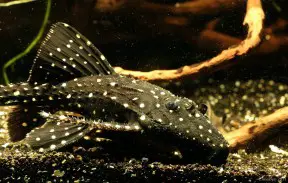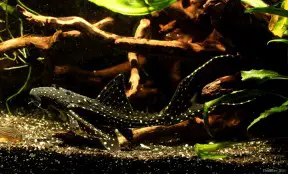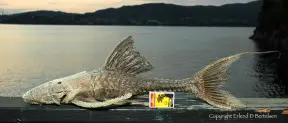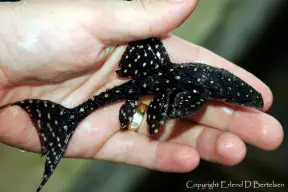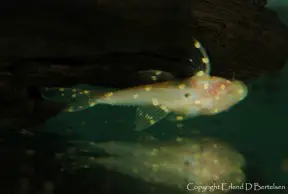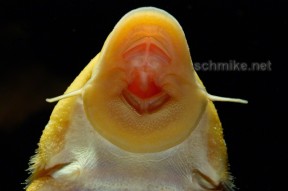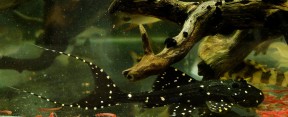Acanthicus adonis
Polka Dot Lyre Tail Pleco, Elfenwels (DE)
Etymology
Acanthicus: from the Greek akánthinos (Gr. ἀκάνθινος), meaning ‘thorny’, in reference to the dorsal surface of the head being covered with erectile spines (odontodes) in type species A. hystrix.
adonis: named for Adonis, who was the handsome mortal lover of the goddesses Aphrodite and Persephone in Greek mythology. Applied in reference to this species’ attractive juvenile colour pattern.
Classification
Order: Siluriformes Family: Loricariidae
Distribution
Described from the lower rio Tocantins near the city of Cametá, Pará state, northern Brazil and occurs throughout the lower part of that system. Although definitive details are lacking, it’s also thought to range throughout much of the Amazon basin with similar-looking fishes being exported from as far afield as Peru.
Habitat
Mostly inhabits slower-moving sections of rivers and tributaries and apparently often associated with human settlements.
Maximum Standard Length
600 – 1000 mm; captive specimens measuring towards the upper end of this range are very rare, though the lower figure is certainly attainable.
Aquarium SizeTop ↑
For an adult specimen aquarium base dimensions in excess of 600 cm x 200 cm are required, meaning this species is largely unsuitable for private aquaria.
Maintenance
Prefers dim lighting and access to refuges in the form of driftwood, large rocks or lengths of plastic piping. Juveniles can be kept in planted aquaria but adults are likely to consume or uproot any vegetation. An enormous filtration system and dedicated regime of water changes will also be required and maintenance of high dissolved oxygen levels is mandatory given the species‘ natural habitat and the fact that unlike some relatives it cannot respire atmospheric oxygen.
Water Conditions
Temperature: 23 – 30 °C
pH: 6.0 – 7.5
Hardness: 36 – 215 ppm
Diet
This species is a generalised detrivore, so offer a varied diet comprising dried, frozen and live foods including sinking tablets, wafers, slices of fruit and vegetables plus meatier fare such as bloodworm, earthworms, prawns, cockles and lancefish. In nature it is reputed to occur close to settlements and feed on human refuse/organic waste at some localities.
Growth may be inhibited if meal size and feeding frequency are insufficient. When purchasing loricariid catfishes, check that the belly and/or eyes do not appear sunken since these are typical signs of malnourishment.
Behaviour and CompatibilityTop ↑
Juveniles tend to be quite peaceful but become more territorial and aggressive as they mature, meaning adults should be maintained singly and unless the aquarium is of public aquaria magnitude, in the absence of other substrate-dwellers. The most suitable tankmates are large, robust, pelagic fishes from genera such as Cichla, Osteoglossum, Brycon, Acestrorhynchus, etc.
Sexual Dimorphism
Males may develop more extensive odontal growth on the pectoral rays, cheeks and body and exhibit more territorial behaviour once sexually mature. The most reliable method is examination of the genital papilla, which in males is comparatively blunter in shape.
Reproduction
Has been achieved but little information is available. Apparently a cave spawner with the male responsible for guarding and tending the eggs.
NotesTop ↑
Despite its patent unsuitability as an aquarium subject attractively-coloured juvenile specimens of this species are traded in quite large numbers, although the scarcity of privately-maintained adults would suggest that most fail to reach their potential. The striking, spotted patterning also disappears as this species matures, and since it also becomes increasingly bellligerent with age it can only be recommended to owners of the largest private aquaria or tropical ponds. There exists an albino form which is available from time-to-time, and another variant exhibits wave-like patterning on the body which is particularly visible on the ventral surface.
The genus Acanthicus currently comprises just two species but there exist a handful of undescribed ones, some of which have been exported for the aquarium hobby. Members are most easily characterised by lacking an adipose fin plus possessing extensive keels along the flanks as well as a greatly-extended pterotic-supracleithrum, a bony formation comprising fused pterotic, posttemporal, and supracleithrum bones and located just above the pectoral girdle. All are extremely spiny meaning extreme care should be taken when netting or otherwise handling them as they can easily become entangled in the mesh of aquarium nets or cause physical injury.
The two described taxa, A. adonis and A. hystrix, are easily distinguished when young since the latter lacks white to yellowish spots on the body. As adults they appear more similar although A. adonis tends to retain some degree of spotted patterning, most often on the fins or fin filaments.
The family Loricariidae is the largest among catfishes with over 700 species described to date and many awaiting description. The latter are typically assigned a specific ‘L’ number by hobbyists and scientists alike in order to provide a basic means of identification, although in some cases several species have been referred to the same number, or multiple numbers have been used for different populations of a single taxon. All loricariids are also commonly referred to as ‘pleco’, ‘plecostomus’ or ‘suckermouth armoured catfishes’.
The closer relationships of member genera have long been of interest to icthyologists but in numerous cases remain unresolved. Isbrücker (1980) was the first to propose an arrangement of six subfamilies, namely Lithogeneinae, Neoplecostominae, Hypostominae, Ancistrinae, Hypoptopomatinae and Loricariinae, and this model was generally followed until publication of Armbruster’s morphological analysis in 2004. His phylogeny also contained six subfamiles, with Isbrücker’?s (1980) Ancistrinae being included as one of five tribes comprising Hypostominae. This was later modified slightly by Reis et al. (2006) and an adapted version of their key is reproduced here:
1a. No lateral and dorsal plates anterior to the dorsal fin: Lithogeneinae
1b. Possession of lateral plates anterior to the dorsal fin (except in Pareioraphis nudulus): 2
2a. Ventral surface of the pectoral girdle exposed (i.e. supporting odontodes) towards the centre of the coracoid strut: Hypoptopomatinae
2b. Ventral surface of the pectoral girdle covered in skin or plates towards the centre of the coracoid strut (odontodes supported by the plates rather than the girdle): 3
3a. Caudal peduncle flattened dorsoventrally; no adipose fin: Loricariinae
3b. Caudal peduncle oval, round, or triangular in cross-section; adipose fin usually present: 4
4a. Postdorsal ridge formed from several preadipose plates arranged singly. Teeth almost symmetrically bifid (divided into two equal parts): Delturinae
4b. Usually no postdorsal ridge. Teeth asymmetrical or unicuspid: 5
5a. Dorsal–fin spinelet V-shaped, dorsal–fin spine can be locked: Hypostominae
5b. Dorsal–fin spinelet rectangular or absent, dorsal–fin spine cannot be locked: Neoplecostominae
Subsequent papers attempting to resolve relationships within the Hypoptopomatinae and Neoplecostominae by Cramer et al. (2008, 2011) have revealed both subfamiles to be polyphyletic arrangements alongside several genera e.g. Pareiorhaphis, Pareiorhina, Hisonotus and Parotocinclus, so there is evidently a great deal of work still to be done. At any rate Acanthicus is currently considered a member of the tribe Ancistrini within Hypostominae and most closely-related to Leporacanthicus, Megalancistrus and Pseudacanthicus.
The sucking disc formed by the mouthparts is common to all representatives but both oral and dental morphology are highly variable depending on a given species‘ ecological adaptation(s). and some species even practice xylophagy (wood eating). Many species are also facultative air-breathers i.e. they possess the ability to respire atmospheric air if necessary.
References
- Armbruster, J. W. , 2004 - Zoological Journal of the Linnean Society 141: 1-80
Phylogenetic relationships of the suckermouth armoured catfishes (Loricariidae) with emphasis on the Hypostominae and the Ancistrinae. - Cramer, C. A., A. M. R. Liedke, S. L. Bonatto, and R. E. Reis, 2008 - Bulletin of Fish Biology 9: 51-59
The phylogenetic relationships of the Hypoptopomatinae and Neoplecostominae (Siluriformes: 725 Loricariidae) as inferred from mitochondrial cytochrome c oxidase I sequences. - Cramer, C. A., S. L. Bonatto, and R. E. Reis, 2011 - Molecular Phylogenetics and Evolution 59(1): 43-52
Molecular phylogeny of the Neoplecostominae and Hypoptopomatinae (Siluriformes: Loricariidae) using multiple genes. - Reis, R. E., E. H. L. Pereira, and J. W. Armbruster, 2006 - Zoological Journal of the Linnean Society 147(2): 277-299
Delturinae, a new loricariid catfish subfamily (Teleostei, Siluriformes), with revisions of Delturus and Hemipsilichthys.

